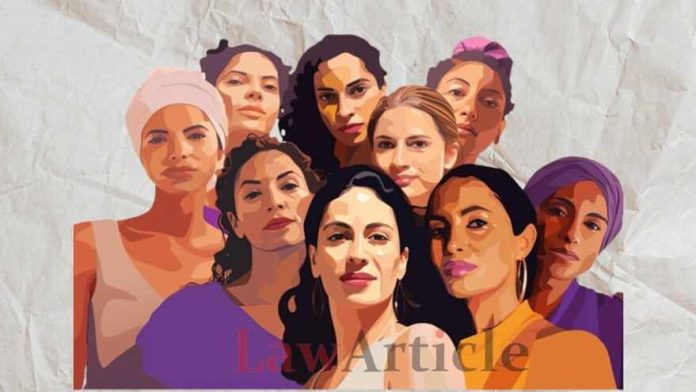Introduction to Women’s Law in India
Women’s rights and legal protections have evolved significantly in India, reflecting a broader societal shift towards gender equality. Over the years, landmark judgments and legislative reforms have shaped the legal landscape concerning women’s rights, addressing issues such as gender-based discrimination, violence against women, property rights, workplace harassment, and reproductive rights. These legal developments have been instrumental in empowering women, promoting their participation in various spheres of life, and fostering a more inclusive and equitable society.
- Vishaka Vs State of Rajasthan
- Background: Bhanwari Devi, a social worker in Rajasthan, was brutally gang-raped by five men in 1992 for her efforts to prevent child marriage. The trial court’s shocking decision to acquit the accused prompted Vishaka, a women’s rights group, to file a petition in the Supreme Court. The case highlighted the absence of laws addressing sexual harassment in workplaces.
- Court Ruling: The Supreme Court, in 1997, commissioned the Vishaka guidelines, defining sexual harassment and mandating preventive measures in workplaces. These guidelines were a pioneering step towards ensuring a safe working environment for women.
- Significance: Vishaka case laid the foundation for legal protection against workplace sexual harassment in India, empowering women to seek justice and promoting gender equality in employment.
- Mary Roy Vs State of Kerala
- Background: Mary Roy, a women’s rights activist, challenged the discriminatory inheritance laws prevalent among Syrian Christian women in Kerala. These laws denied women equal rights to ancestral property.
- Court Ruling: In 1986, the Supreme Court’s landmark judgment granted equal inheritance rights to Syrian Christian women, setting a precedent for gender equality in property rights.
- Significance: Mary Roy’s case marked a significant stride towards dismantling gender-biased inheritance laws and promoting equal rights for women in ancestral property matters.
- Lata Singh Vs State of Uttar Pradesh
- Background: Lata Singh’s case revolved around her choice to marry a person from a lower caste against her family’s wishes. Her family filed false abduction charges against her husband, leading to legal troubles.
- Court Ruling: The Supreme Court’s verdict in 2006 upheld adults’ rights to choose their life partners irrespective of caste or religion. It also directed action against those who engage in violence against such couples.
- Significance: This case reinforced individuals’ fundamental rights to personal liberty and freedom of choice in marriage, challenging societal barriers based on caste or religion.
- Roxann Sharma Vs Arun Sharma
- Background: Roxann Sharma’s case involved a bitter custody battle over her child with her estranged husband. Despite a court granting her interim custody, her husband violated the order.
- Court Ruling: The Supreme Court’s ruling prioritized the welfare of children in custody disputes, particularly emphasizing the mother’s role for children under five years of age.
- Significance: This case underscored the importance of considering the child’s best interests in custody matters and established guidelines for resolving such disputes.
- Tamil Nadu Vs Suhas Katti
- Background: Suhas Katti’s harassment of a woman who rejected his marriage proposal escalated to cyber harassment and defamation through online platforms.
- Court Ruling: The Supreme Court’s judgment in this case marked the first conviction under the Information Technology Act, recognizing cyber harassment as a punishable offense.
- Significance: The ruling set a precedent for addressing online harassment and protecting individuals’ digital rights, particularly safeguarding women against cyberbullying and defamation.
- Laxmi Vs Union Of India
- Background: Laxmi, an acid attack survivor, petitioned the court to regulate acid sales and provide adequate compensation for victims.
- Court Ruling: In 2013, the Supreme Court imposed strict regulations on acid sales, requiring valid identity proof and purpose declaration for purchases. It also mandated reporting of acid sales to authorities and prohibited sales to minors.
- Significance: This case brought attention to the alarming issue of acid attacks and led to concrete measures to prevent such heinous crimes, ensuring better protection and support for acid attack survivors.
- Centre for Inquiry into Health and Allied Themes (CEHAT) Vs Union of India
- Background: The petition addressed the alarming trend of female feticide through prenatal diagnostic techniques, highlighting the need for stringent implementation of the Pre-Conception and Pre-Natal Diagnostic Techniques (Prohibition of Sex Selection) Act (PCPNDT Act).
- Court Ruling: The Supreme Court directed immediate enforcement of the PCPNDT Act, banning advertisements related to prenatal sex determination and emphasizing stringent penalties for violators.
- Significance: This case played a crucial role in curbing female feticide and promoting gender equality by addressing the misuse of prenatal diagnostic techniques for sex determination.
- Termination of 24-week-old pregnancy permitted on account of abnormal fetus
- Background: A rape survivor sought permission to terminate her pregnancy beyond the 20-week limit due to fetal abnormalities, challenging the Maternal Termination of Pregnancy Act’s restrictions.
- Court Ruling: The Supreme Court, considering the risk to the mother’s life, permitted the termination, highlighting the need for compassionate and pragmatic interpretations of abortion laws in exceptional cases.
- Significance: This case highlighted the complexities of abortion laws and emphasized the importance of balancing women’s reproductive rights with medical considerations in sensitive situations.
Impact of Landmark Judgments on Women Today
The impact of landmark judgments concerning women’s rights in India has been profound and far-reaching, shaping the lives of women across the country in several ways:
- Gender Equality: Judgments like Vishaka Vs State of Rajasthan, which defined sexual harassment guidelines, have empowered women in the workplace by creating safer environments and establishing mechanisms for addressing harassment.
- Property Rights: Rulings such as Mary Roy Vs State of Kerala have contributed to greater gender parity in property inheritance, enabling women to assert their rights to ancestral property on an equal footing with men.
- Choice in Marriage: Cases like Lata Singh Vs State of Uttar Pradesh have affirmed individuals’ right to choose their life partners irrespective of caste or religion, challenging societal norms and promoting personal autonomy.
- Child Custody: Landmark judgments on child custody, such as Roxann Sharma Vs Arun Sharma, have prioritized the welfare of children and recognized the crucial role of mothers in their upbringing, ensuring fair outcomes in custody disputes.
- Cyber Harassment: Legal precedents set by cases like Tamil Nadu Vs Suhas Katti have addressed emerging challenges such as cyber harassment, providing women with recourse against online abuse and defamation.
- Acid Attack Survivors: Cases like Laxmi Vs Union Of India have led to stringent regulations on acid sales, offering greater protection to acid attack survivors and deterring such heinous crimes.
- Reproductive Rights: Judicial decisions concerning abortion rights, as seen in cases permitting termination of pregnancies due to fetal abnormalities, have upheld women’s reproductive autonomy and health.
These judgments have not only provided legal remedies but also fostered a culture of accountability, awareness, and empowerment among women, encouraging them to assert their rights and seek justice when faced with discrimination or violence.
Need of the Hour
Despite significant progress, several challenges persist, highlighting the ongoing need for legal reforms and societal change to further advance women’s rights in India:
- Implementation: Ensuring effective implementation of existing laws and judgments remains crucial to translating legal protections into tangible benefits for women on the ground.
- Awareness and Education: Promoting awareness about women’s rights, legal remedies, and support services is essential to empower women with knowledge and encourage them to assert their rights.
- Addressing Violence: Tackling gender-based violence, including domestic violence, sexual assault, and harassment, requires comprehensive legal frameworks, support systems, and preventive measures.
- Economic Empowerment: Enhancing economic opportunities, access to education, and skills development for women is vital to promote financial independence and reduce gender disparities.
- Intersectional Approach: Recognizing the intersectionality of gender with other factors such as caste, class, religion, and disability is crucial in formulating inclusive and equitable policies and legal interventions.
- Advocacy and Collaboration: Collaborative efforts involving government agencies, civil society organizations, legal experts, and community leaders are essential to advocate for women’s rights, drive policy reforms, and create a supportive environment for gender equality.
CONCLUSION
In conclusion, the evolution of women’s law in India reflects a progressive shift towards gender equality, empowerment, and justice. Landmark judgments have played a pivotal role in shaping legal frameworks, challenging societal norms, and empowering women to assert their rights across various domains. These judgments have had a profound impact on women today, influencing their lives in terms of workplace safety, property rights, marital autonomy, and protection against various forms of violence and discrimination.
However, despite significant progress, challenges persist, necessitating ongoing legal reforms, awareness campaigns, and collaborative efforts to address gender-based inequalities and promote women’s rights. The need of the hour includes effective implementation of existing laws, increased awareness and education, comprehensive strategies to address violence, economic empowerment initiatives, an intersectional approach to policy-making, and sustained advocacy and collaboration among stakeholders.
Looking ahead, the momentum towards gender equality and women’s empowerment must continue, driven by a collective commitment to creating a society where women can thrive, contribute meaningfully, and live with dignity, respect, and equal opportunities. Through continued legal advocacy, social initiatives, and policy interventions, India can further strengthen its position as a champion of women’s rights and a beacon of progress toward gender equality on the global stage.
Also Read:
Rights of undertrial prisoners in India
How To Send A Legal Notice In India




